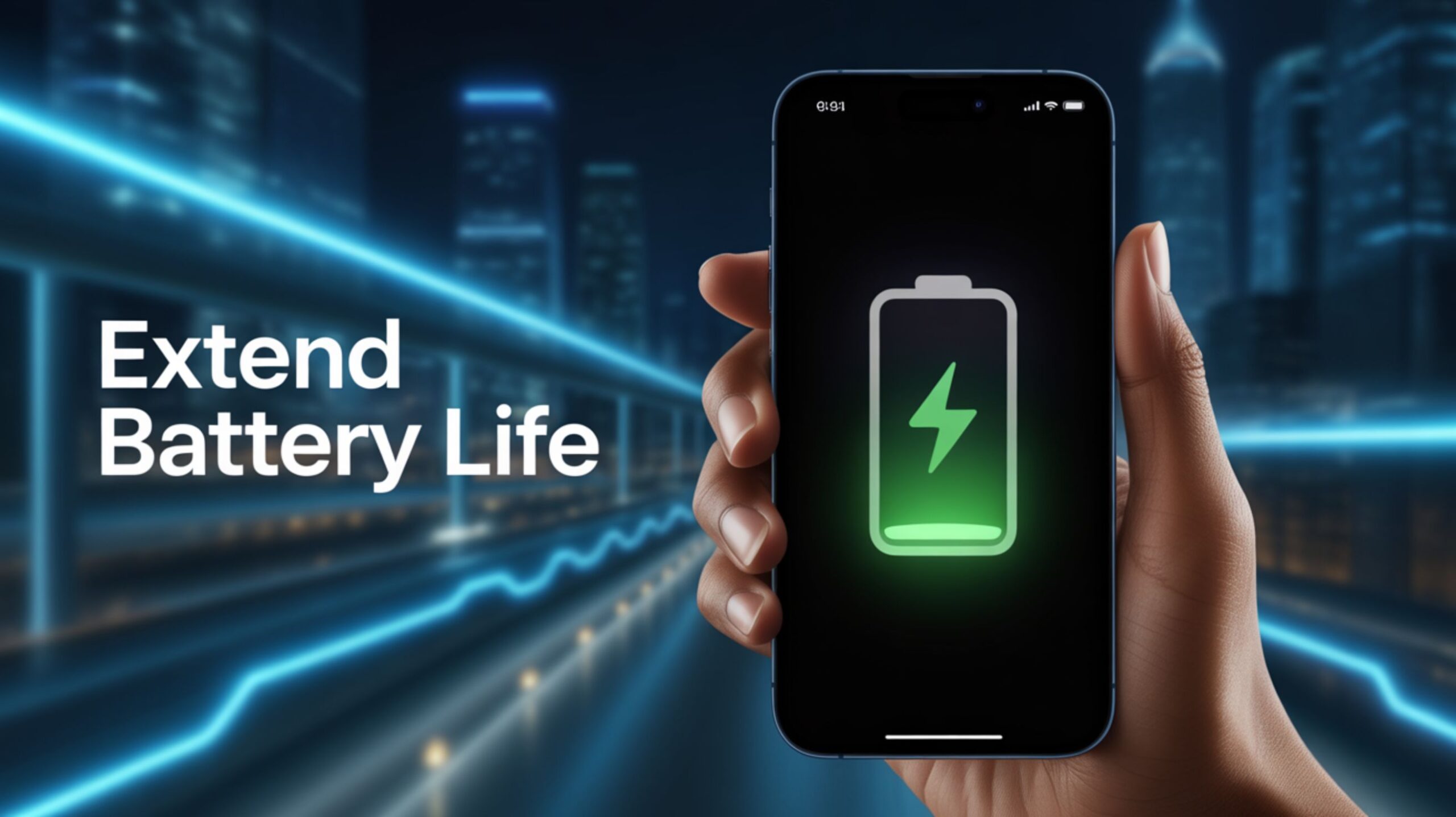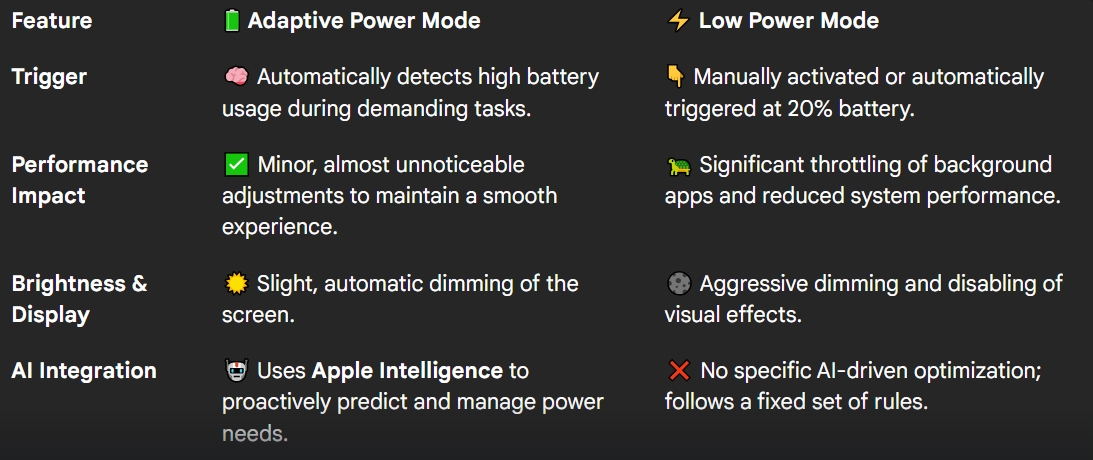Apple has officially unveiled iOS 26, the next-generation operating system for iPhones, bringing a wave of innovation powered by Apple Intelligence. While much attention has been given to groundbreaking features like Liquid Glass and smarter Siri integrations, one underrated addition could transform how we manage iPhone battery life — the AI-Powered Adaptive Power mode. This Smart battery saver dynamically learns user behaviour, adapts in real time, and ensures that your device lasts longer without sacrificing performance unnecessarily. Below, we provide a detailed guide on enabling Adaptive Power in iOS 26, supported devices, and everything you need to know about maximizing your iPhone’s battery performance.
What is Adaptive Power in iOS 26?
Adaptive Power is a new AI-driven power management feature built into iOS 26. Unlike the traditional Low Power Mode, which drastically reduces background processes once the Battery dips below 20%, Adaptive Power uses machine learning to predict and optimise energy usage during high-demand tasks.
For example, when you’re:
- Recording 4K HDR videos
- Playing graphics-heavy games
- Editing high-resolution photos or videos
- Using augmented reality (AR) applications
…the system automatically adjusts performance, display brightness, and background activities to extend your device’s runtime.
Apple describes it as:
“When your battery usage is higher than usual, iPhone can make small performance adjustments to extend your battery life, including slightly lowering the display brightness or allowing some activities to take a little longer. Low Power Mode may turn on at 20%.”
This ensures a seamless user experience while conserving energy intelligently.
Key Differences Between Adaptive Power and Low Power Mode
Many users may wonder whether Adaptive Power is another version of Low Power Mode. Here’s how they differ:

With Adaptive Power, you retain better performance balance while still saving Power, unlike Low Power Mode’s aggressive restrictions.
How to Enable Adaptive Power in iOS 26
The Adaptive Power feature is not turned on by default. Here’s a step-by-step guide to enabling it:
- Update to iOS 26
- Ensure your iPhone is running the latest iOS 26 Developer or Public Beta.
- Go to Settings > General > Software Update and install the update.
- Navigate to Battery Settings
- Open Settings.
- Scroll down and tap Battery.
- Find Power Mode Options
- Tap Power Mode under the Battery section.
- You will see Adaptive Power listed above Low Power Mode.
- Activate Adaptive Power
- Toggle the switch next to Adaptive Power.
- Your iPhone will now intelligently optimise power consumption.
Which Devices Support Adaptive Power?
Apple has confirmed that Adaptive Power is only available on devices that support Apple Intelligence. Older iPhones will not receive this option, as the feature relies on on-device AI models and advanced chipsets.
Here is the list of supported iPhones:
- iPhone 15 Pro
- iPhone 15 Pro Max
- iPhone 16
- iPhone 16 Plus
- iPhone 16 Pro
- iPhone 16 Pro Max
- iPhone 16e
- iPhone 17 series (all models)
You will not see the Adaptive Power toggle under Battery settings if you own an older iPhone (such as the iPhone 14 or iPhone 15 standard models).
Why Adaptive Power Matters for iPhone Users
The demand for longer-lasting batteries continues to grow as iPhones become more powerful. With features like ProMotion displays, advanced cameras, and AI-driven multitasking, battery drain is inevitable.
Adaptive Power addresses this challenge by:
- Reducing performance spikes during intense workloads
- Maximising battery efficiency without manual toggling
- Minimising background power drain intelligently
- Extending screen-on time for gaming, media, and productivity
It gives you the best of both worlds — excellent performance when needed, and extended Battery when you don’t.
Best Practices to Maximise Battery Life with Adaptive Power
While Adaptive Power is a powerful tool, combining it with existing battery optimisation tips can significantly extend your iPhone’s runtime. Here are expert-recommended practices:
- Enable Auto-Brightness – Allow iOS to adjust brightness dynamically.
- Update Apps Regularly – Developers optimise apps for iOS 26 to improve efficiency.
- Use Wi-Fi over Cellular Data – Cellular drains more Battery.
- Limit Background App Refresh – Especially for non-essential apps.
- Turn Off Location Services When Not Needed – Apps like Maps and social media drain power.
- Use Dark Mode – Particularly effective on OLED displays.
Combining these practices with Adaptive Power mode can extend battery life by 25–30% in real-world use cases.
Troubleshooting Adaptive Power Issues
Some users may not see Adaptive Power after updating to iOS 26. Here’s what to check:
- Device Compatibility: Ensure your iPhone is 15 Pro or newer.
- Correct iOS Version: Verify that you’re running iOS 26 Developer/Public Beta.
- Battery Settings Refresh: Restart your device and recheck under Settings > Battery.
- Beta Bugs: As iOS 26 is still rolling out, minor glitches may delay feature visibility. Apple usually resolves these in incremental updates.
Future of AI-Powered Battery Optimisation in iPhones
Adaptive Power is just the first step toward a fully AI-managed iPhone ecosystem. In future updates, we may see:
- Predictive Charging – AI learns your schedule and charges accordingly.
- Innovative Background Task Management – Apps allowed to run only when needed.
- Custom Battery Profiles – User-defined modes for gaming, productivity, or travel.
As Apple Intelligence becomes more advanced, iPhone users can expect even more intelligent energy management in upcoming generations.
Wrap Up
The new iOS 26 Adaptive Power feature represents a significant leap forward in iPhone battery management. By leveraging AI-powered optimisation, Apple ensures users enjoy extended battery life without constantly toggling between modes or sacrificing essential performance.
If you’re running iOS 26 on a compatible iPhone, enabling Adaptive Power should be one of the first settings you activate to get the most out of your device.

Selva Ganesh is a Computer Science Engineer, Android Developer, and Tech Enthusiast. As the Chief Editor of this blog, he brings over 10 years of experience in Android development and professional blogging. He has completed multiple courses under the Google News Initiative, enhancing his expertise in digital journalism and content accuracy. Selva also manages Android Infotech, a globally recognized platform known for its practical, solution-focused articles that help users resolve Android-related issues.




Leave a Reply